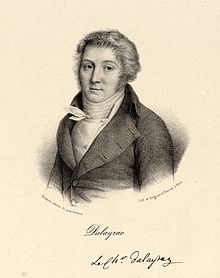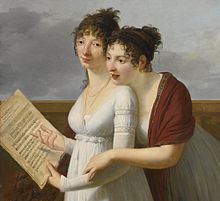Nicolas Dalayrac

Nicolas-Marie d'Alayrac, known as Nicolas Dalayrac (8 June 1753 – 26 November 1809) was a French composer, best known for his opéras-comiques.
Biography
Dalayrac was born in Muret, Haute-Garonne. Although trained as a lawyer, he was encouraged by his father to abandon his career and follow his passion for music. His earliest works were violin duets, string trios and quartets, but his main fame was as a prolific composer of operas for the Comédie-Italienne (later remamed the Opéra-Comique). He was a Freemason and is said to have composed the music for the induction of Voltaire to his lodge.[citation needed] He married the actress Gilberte Pétronille Sallarde. After the French Revolution he changed his name from the aristocratic d'Alayrac to Dalayrac. In 1804, he received the Légion d'honneur. He died in Paris, aged 56.
Opéras-comiques
1780–1789
- Le chevalier à la mode (1781)
- Le petit souper (1781)
- L'éclipse totale (1782)
- L'amant statue (1785)
- La dot (1785)
- Nina, ou La folle par amour (1786)
- Azémia (2 parties, 1786)
- Renaud d'Ast (1787)
- Sargines (1788)
- Fanchette (1788)
- Les deux petits Savoyards (1789), libretto by Benoît-Joseph Marsollier des Vivetières, first performance by Les Comédiens ordinaires du Roi, 14 January 1789.
- Raoul, sire de Créqui (1789)
1790–1799
- La soirée orageuse (1790)
- Le chêne patriotique (1790)
- Vert-Vert (1790)
- Camille ou Le souterrain (1791)
- Agnès et Olivier (1791)
- Philippe et Georgette (1791)
- Tout pour l'amour (1792)
- Ambroise (1793)
- Asgill (2 parties, 1793)
- La prise de Toulon (1794)
- Le congrès des rois (1794)
- L'enfance de Jean-Jacques Rousseau (1794)
- Les détenus (1794)
- Adèle et Dorsan (1795)
- Marianne (1796)
- La maison isolée (1797)
- La leçon (1797)
- Gulnare (1797)
- Alexis (1798)
- Léon (1798)
- Primerose (1798)
- Adolphe et Clara, ou Les deux prisonniers (1799)
1800–1809

- Aire de Maison à vendre (1800)
- Léhéman (1801)
- L'antichambre (1802)
- La boucle de cheveux (1803)
- La jeune prude (1804)
- Une heure de mariage (1804)
- Le Pavillon du Calife, ou Almanzor et Zobéïde, opera in two acts and in free verse, in collaboration with Jean-Baptiste-Denis Despré and Étienne Morel de Chédeville (1805)
- Le pavillon des fleurs (1805)
- Gulistan ou Le hulla de Samarcande (1805)
- Deux mots (1806)
- Koulouf ou Les chinois (1806)
- Lina (1807)
- Élise-Hortense (1808)
- Les trois sultanes (1809)
- Le poète et le musicien (1809, op. post., f.p. 1811)
